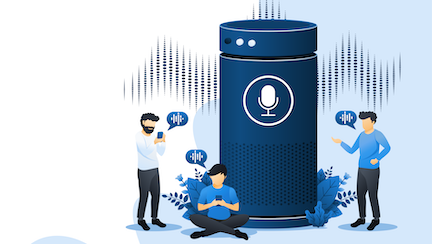
How creative marketing content persuades you.
How marketing content persuades. A spoonful of creativity helps the inhibition go down.
Ever wonder why a lot of advertising and marketing materials don’t rationally explain the benefits of their product? Or to put it another way, why do I need to see two naked people in a bathtub to help me understand why I should by Cialis? Can’t you just tell me (I mean, a friend of mine) it’s a drug for erectile dysfunction?
Early advertising and persuasion: just the facts, Ma’am.
Advertising once did, years ago. In the early days of advertising (which by the way is a term that literally means making announcements), signs and ads factually announced a company’s products and services in order to make the public aware of their existence. And for a while, simply connecting consumers to information about the products they needed was enough to persuade and help a business to grow.

But as more products came on the market, competition increased. As companies wanted to grow further and to persuade, it was no longer enough to simply let consumers know about a product. To optimize sales and our greater economy, it was important to make them want it – even if they didn’t specifically or rationally need it.
The change: persuasion focused on our want instead of need.
Need is a logical process. For example, I need a hole made. Therefore, I need a shovel. With need, rationality and intellect usually set the guidelines that drives persuasion for such a purchase.
Want is different. Want is often unmoored from clear need and, consequently, logic and rationale. Instead, it is powered by factors ranging from desire, vanity, self-esteem, a need for status, etc. For example, I want a zillion dollars. Or I want a football autographed by Nick Foles. Do I need them? Probably not (Pssst. Hey, Nick Foles, I really do need that football).
To persuade beyond a person’s logical or intellectual guardrails, advertisers had to begin speaking to the want drivers in consumers. To find messages and experiences to stimulate feelings of happiness, like, fear and desire. With those stimulated, consumers often put their intellect and rationale in the backseat and become emotionally attracted and focused by their want.
YOUR INTELLECT: That car is expensive.
AD MESSAGE: But it’s cool. It looks fast. Zoom! Zoom!
YOUR INTELLECT: But it’s expensive and will blow my budget.
AD MESSAGE: Hey, you work hard. Your boss is a jerk, right? You deserve to treat yourself.
YOUR WANT: Yea. Shut up, Intellect. Sold!
Why creativity works in persuading us.
Creativity in advertising persuades by avoiding direct, logical talk. Instead it creates a visceral, unmoored experience that speaks to your feelings and wants. That is, unless you can personally show me how you draw a straight line between two naked people in two bathtubs and medicine for erectile dysfunction.
Speaking of which, the Cialis ad I mentioned contains visceral hints (sub communications) about attractive or desirous benefits of the product. Naked people (Are we talking about sex?). Pleasurable, sensual moments (bathtub). The people are happy (sexual satisfaction) in those bathtubs. These cues of imagery and action all get packaged in this bizarre, yet entertaining TV ad.
The entertainment value around all those visual cues turns them into sub-communications. At this point, I should probably define sub-communication. Famous pollster and skilled communicator Frank Luntz revealed in the title of one of his books, “It’s Not What You say, It’s What People Hear.” That’s sub-communication. In short, the most obvious message presented is not the real or intended message that’s being delivered.
For instance, imagine you are laughing at an ad. An ad where a clumsy guy is trying to impress a woman. The guy is able to do it when comedy and fate makes it accidentally look like he’s driving this super cool car that’s not really his. The obvious message is fumbling, awkward guy is funny to watch. The sub-communicated message is that the right car will help you get the girl.
While crafting copy as a copywriter, I used to think of sub-communication as a way you can make an argument in a way that isn’t making a statement that makes your client’s legal department nervous. It’s as if to say, “I didn’t say the words buying this car will help you get women. It’s just a funny story that’s a one-off story and, of course, not implying a fact that can be legally challenged.”
Changing your mood persuades you to change your opinion.
Creating a mood in creative messaging affects your ability to evaluate a presentation. Changing one’s mood also helps change one’s mind. If an ad or message gets you to laugh at something that you were once indifferent about or even hated, you’re often forced to reconcile your new like against your previous feeling. That can nudge you to change as we tend to accept ideas from people and sources we like.
How powerful is creativity’s persuasion in content? We have regulations about it.
It’s why consumer groups and government regulations get concerned about creative advertising to children. When I did children’s advertising, I understood there were rules about how ads were presented to children. For instance, you had to be conscious of TV ads conflating magic or fantasy portrayed in the ad with the actual toy product as purchased. This was so children, who often don’t have the rational guardrails to evaluate a commercial pitch, don’t come to believe the toy will actually produce magic.

Because the Cialis ad I mentioned talks about a regulated prescription drug, it also operates in what’s called a regulated market. Similar to children’s advertising, there are rules to manage expectations of the benefits of what they can expect from the use of a drug.
So rub and dub dub, no nooky the tub. And so you don’t get confused by the sub-communications of naked people and bathtubs, ask your doctor if Cialis is right for you.































